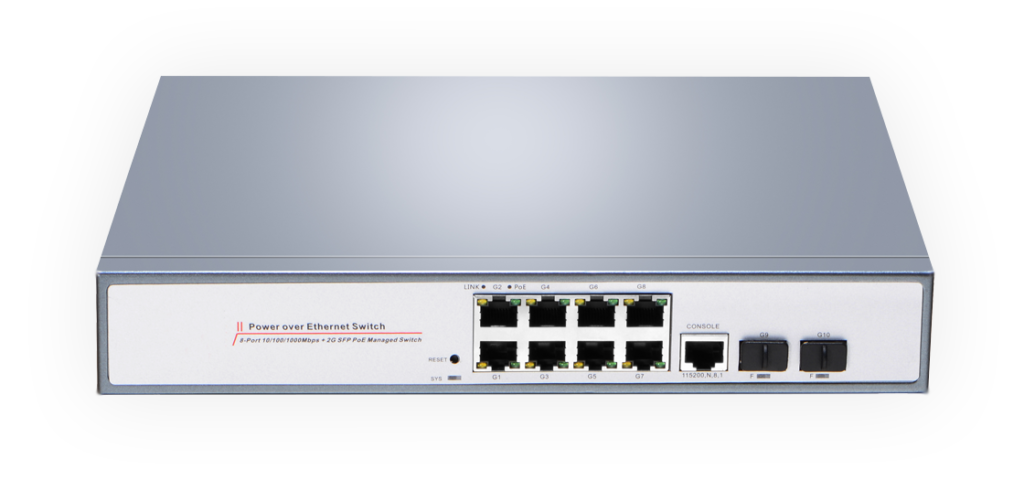The Power over Ethernet (PoE) lets Ethernet cables supply the power for network devices, at the same time as transmitting data in the normal way. Typical PoE users are businesses adding to their network or adding VoIP phones in buildings where new power lines would be expensive or inconvenient. So why not choose a PoE switch? PoE switches give you an easy way to add PoE devices to your network. The plug-and-play switches will automatically detect whether connected devices are PoE or PoE+ and send power accordingly. Choose managed PoE switches to control multiple devices from the data center. For simpler operations, choose more economical unmanaged PoE switches is enough. Now, let’s get close to PoE and PoE switches.
What Is Power over Ethernet?
Power over Ethernet is a technology that lets network cables carry electrical power. For example, a digital security camera normally requires two connections to be made when it is installed. One is a network connection, in order to be able to communicate with video recording and display equipment. Another is a power connection, to deliver the electrical power the camera needs to operate. However, if the camera is POE-enabled, only the network connection needs to be made, as it will receive its electrical power from this cable as well.
Currently, there are two standards approved by the IEEE. The first, approved in 2003, is IEEE 802.3af and specifies up to 15.4 watts of direct current (DC) power. The second standard, ratified in 2009 as IEEE 802.3at, is commonly called high power PoE (HPoE) or PoE+ and doubles the power capabilities to 30 watts. Both standards have a maximum distance of 100 meters (328 feet) that is dictated by the distance limitation of Ethernet network cable. The 48VDC voltage used in plain old telephone service (POTS) analog circuits is what is commonly used for today’s PoE systems.
Upgrade to PoE with a PoE Switch
A basic PoE-based system usually consists of three main components: power-sourcing equipment (PSE), such as a PoE switch, category network cable and remote-powered devices, which may be an IP camera, IP access panel, IP intercom, VoIP or wireless access point (WAP). PSE is the most critical one among them, which is a device that injects power onto the same network cable that is being used for data. The injector can be a stand-alone single-port or multiport device, or the injector can be built into a network switch, which is called a PoE switch. The second option is more common today due to the convenience of using a single integrated device. PoE switch is not just handling data transmission, but also serving as the centralized power source for the video surveillance system. Therefore, upgrade your network to PoE is straightforward, and you just need to choose a PoE switch. Following figure is a 8 port PoE switch.

How to Choose a PoE Switch?
Although PoE is primarily designed as a plug-and-play technology, not all PoE switches are designed to deliver the full demands of maximum PoE on each port. PoE switches are sold at different price points and applications, from low-cost unmanaged edge switches with a few ports, up to complex multi-port rack-mounted units with sophisticated management. It’s easy to make a purchase decision based on the lowest price. However, the cheaper PoE switch will typically have a less robust power supply and may not provide the full power required by PoE endpoints. Therefore, selecting the right PoE switch for a job can be challenging. Following are some simple guidance that might help.
Firstly, you should make sure how many ports you need to support your PoE devices. After finding a PoE switch that will provide suitable power conditions on a per-port basis, there is another element to consider—power budget. For example, you bought four cameras to use four cameras, not to use just one or two. Then will the switch you choose provide enough power per port for each camera? Will the switch provide suitable power to all ports at all times? Finally, after considering space in your panel, power demands of one device, power ability of a switch for one port, and powering ability of a switch across all ports, you are prepared to make a decision!

Conclusion
The power consumption for PoE switches can add up quickly when there are multiple IP cameras, access control devices, outdoor heater/blowers, etc. The keys to choosing a right PoE switch is to make sure that the network switch can provide the necessary wattage of PoE that will be needed for each device, and that the aggregate wattage necessary to power all devices simultaneously is available. Fiberstore provides PoE switches in a variety of specifications, which may make your trip as comfortable as possible. For more information, please feel free to contact us at sales@fs.com.
